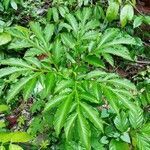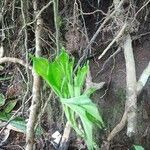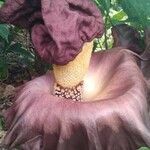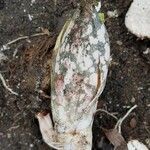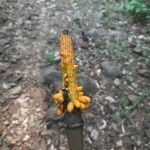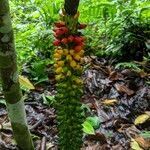Tuber dark brown, depressed globose, ca. 20 cm high, to ca. 30 cm in diam., weighing up to ca. 15 kg; root scars prominent, annulate; offsets produced every season, thick and rhizomatous, to ca. 10 × 4 cm. Leaves 1 or 2; petiole background pale to dark green or blackish green, usually with large and small pale blotches and numerous tiny dark dots, large blotches often confluent, especially near base, petiole to ca. 2 m × 20 cm, shallowly corrugate to strongly echinate-verrucate; leaf blade highly dissected, to ca. 3 m in diam.; rachises narrowly or broadly winged almost to base; leaflets abaxially mid-green or pale green, adaxially mid-green, orbicular, oval, ovate, obovate, elliptic, elliptic-oblong, elliptic-lanceolate, or lanceolate, 3-35 × 2-12 cm, apex acuminate. Inflorescence shortly pedunculate; peduncle 3-20 × 1-8 cm, usually paler and more glabrous than petioles. Spathe campanulate, broader than long, 10-45 × 15-60 cm, base and limb often separated by a shallow constriction; limb spreading, background ranging from pale green to dark brown, usually with both large and small, orbicular paler spots, base inside proximal part deep maroon, distal part dirty whitish or very pale pinkish, limb outside as base but with more prominent maroon flushes, especially near margin, limb inside usually glossy dark maroon, strongly undulate, base outside very variable, base within densely verrucate, verrucae variable, mostly conic, fleshy. Spadix giving off a stench of rotting meat, sessile, shorter or longer than spathe, 7-70 cm; female zone cylindric, 3-25 × 1-12 cm, flowers congested or slightly distant; ovary entirely pale green or largely maroon with a whitish base, depressed, orbicular in cross section, 1.5-2.5 mm high, 3-5 mm in diam., 2-or 3-loculed; style maroon, 3-15 mm, slender, 1-1.5 mm in diam.; stigma pale or deep yellow, oval or triangular in cross section, large, 3-5 mm high, 4-7 mm in diam., often strongly laterally compressed, then cordate in longitudinal section, verruculose, shallowly or deeply 2-or 3-lobed, lobes rounded or conic, sometimes with a strong groove on outward side; male zone cylindric or strongly obconic, 2.5-15 cm, 1-10 cm in diam. at base, 1-20 cm in diam. at apex, flowers congested; male flowers consisting of 4-6 stamens; stamens 4-6 mm; filaments ca. 0.5 mm, connate; anthers off-white, cylindric, 3.5-5.5 × ca. 1.5 mm, subtruncate; pollen psilate; appendix very variable, glossy dark maroon, rarely pinkish or yellow, inflated, globose, depressed globose, ovoid, or triangular-conic (pyramidal), 1.5-30 cm, 1.2-30 cm in diam. (slightly above base), minutely granulate, glabrous or with various folds and/or irregular shallow depressions, base often with flattened, staminodal structures, apex obtuse or ± acute. Infructescence long pedunculate; peduncle stretching strongly after fertilization, 20-100 cm, becoming uniformly tan, with very numerous narrow, transverse cracks; fruiting zone cylindric, 10-50 × 3-8 cm. Berries closely set or slightly distant, ripening from green through yellow to bright red, elongate, 1.5-2 cm × 8-10 mm. Fl. Apr-May, fr. Oct-Nov.
More
A taro family plant but with a very divided leaf. It grows to 0.75-1 m high. It is a herbaceous plant with rough and mottled leaf stalks. It has a straight stem and the leaf is divided into leaflets. The leaves can be 1 m in width. The leaves usually come singly from the ground. The leaf blades are divided into many lobes. The leaflets can be 3-35 cm long and 2-13 cm wide. The flower stalk can be 3-20 cm long. The bract around the flower is bell shaped and fluted. It can be 60 cm across. The edge is curved back and wavy. The flower is dull purple and up to 30 cm across. It can be 70 cm long. The flower gives of a bad smell like rotting meat and this attracts flies. The flower only develops after the leaves have died off. The leaves and corms especially in the wild varieties contain many stinging crystals. Edible kinds have a smooth petiole. It has a large round tuber up to 25 cm across. The large round underground corm produces small corms around the side. These can be 10 cm long. These are usually used for planting.
Robust to massive geophytic herb; corm hemispheric, to c. 50 cm diam., sometimes with irregular offsets. Leaf to c. 1.3 m tall; petiole copiously warty, green, mottled pale greygreen; rachises and ultimate rachillas densely leaflet-bearing; leaflets with close-spaced primary venation. Inflorescence on a short peduncle, briefly with a powerful odour of rotting flesh; spathe campanulate, to 60 cm tall and across (usually less in Australia), basally brownish green and mottled, distally purplish within; spadix subsessile, shorter than spathe; female zone with numerous close-spaced pistils with prominent stigmas on long styles; stamens close-packed, bright yellow; appendix much inflated, almost hollow, purple, irregularly bluntly conic; female zone and peduncle much elongating in fruit. Fruits elliptic, ripening red through yellow in a basipetal sequence.
It is quite distinct from the native East African species in the subglobose to broadly conic, coarsely furrowed and crumpled spadix appendix, surrounded by a campaniform purple spathe.
